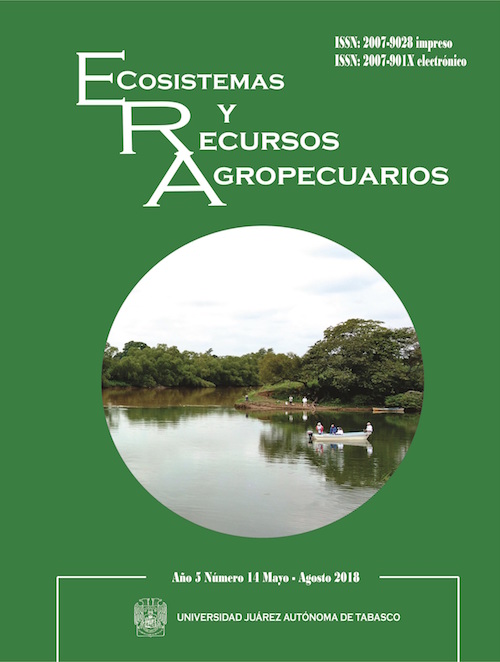Hydrodynamics and measurement of natural currents in a plain river using acoustic Doppler equipment
DOI:
https://doi.org/10.19136/era.a5n14.1515Abstract
Flow discharge and hydrodynamic field measurements are essential data for understanding aquatic ecosystems. The objective of this study was to compare the use of three Acoustic Doppler Current Profilers (ADCPs) in measuring flow discharge and hydrodynamics in the Carrizal River located in southeastern Mexico. The evaluated ADCPs operate on frequencies of 2 000 kHz, 1 500 kHz and 600 kHz. The measurements were carried out in a 100-m-wide cross section, five times each for each ADCP, within an estimated time of 5 min. The obtained data were: 1) flow velocity components; 2) depth; 3) transversal distance between each vector; 4) total distance of the cross section and; 5) geographic position of each vector. Tecplot® graphics were made with the collected information.The results showed that velocity magnitudes were low in bank areas, while high in the center. For a 5-m depth range, the 2 000-kHz ADCP keeps a more homogenous velocity distribution in comparison with the other equipment. The results showed that discharge measurements varied by no more than 5% among ADCPs. It is concluded that the most important variable in choosing an ADCP for a hydrodynamic study is its operating frequency
Downloads
References
Arega F (2013) Hydrodynamic modeling and characterizing of Lagrangian flows in the West Scott Creek wetlands system, South Carolina. Journal of Hydro-environment Research 7: 50-60.
Baranya S, Olsen NRB, Józsa J (2015) Flow analysis of a river confluence with field measurements and RANS model with nested grid approach. River Research and Applications 31: 28-41.
BGS (2015) World Magnetic Model 2015 Calculator. http://www.geomag.bgs.ac.uk/data_service/models_compass/wmm_calc.html. Date consulted: January 1, 2016.
Chang NB, Crawford AJ, Mohiuddin G, Kaplan J (2015) Low flow regime measurements with an auto-matic pulse tracer velocimeter (APTV) in heterogeneous aquatic environments. Flow Measurement and Instrumentation 42: 98-112.
Cundy AB, Lafite R, Taylor JA, Hopkinson L, Deloffre J, Charman R, et al. (2007) Sediment transfer and accumulation in two contrasting salt marsh/mudflat systems: the Seine estuary (France) and the Medway estuary (UK). Hydrobiologia 588: 125-134.
Fulford JM, Sauer VB (1986) Comparison of velocity interpolation methods for computing open-channel discharge. In: Geldon ALSY (ed.) Selected papers in the hydrologic sciences: U.S. Geological Survey Water-Supply Paper 2288. Colorado, United States. pp: 139-144.
García-Reyes M, Priego-Hernández G, Soto-Cortes G, Rivera-Trejo F (2017) Análisis hidrodinámico en un canal de derivación: caso el Censo, municipio de Centro, Tabasco. Journal of Energy, Engineering Optimization and Sustainability 1: 23-42.
Latosinski FG, Szupiany RN, García CM, Guerrero M, Amsler ML (2014) Estimation of concentration and load of suspended bed sediment in a large river by means of acoustic Doppler technology. Journal of Hydraulic Engineering 140(7). Doi: 10.1061/(ASCE)HY.1943-7900.0000859.
Mueller DS (2002) Field assessment of acoustic Doppler based discharge measurements. Proceedings, Hydraulic Measurements and Experimental Methods 2002, ASCE, Reston, Va. CD-ROM
Mueller DS, Wagner CR, Rehmel MS, Oberg KA, Rainville F (2009) Measuring discharge with acoustic Doppler current profilers from a moving boat. US Department of the Interior, US Geological Survey. 72p.
Muste M, Yu K, Spasojevic M (2004) Practical aspects of ADCP data use for quantification of mean river flow characteristics; Part I: moving-vessel measurements. Flow measurement and instrumentation, 15: 1-16.
Pérez AK, Díaz FF (2000) Manual de aforos. Instituto Mexicano de Tecnología del Agua. Morelos, México. 137p.
Priego-Hernandez G, Rivera-Trejo F (2016) Secondary currents: Measurement and analysis. Atmósfera 29: 23-34.
Rennie CD, Millar RG, Church MA (2002) Measurement of bed load velocity using an acoustic Doppler current profiler. Journal of Hydraulic Engineering 128: 473-483.
Riley JD, Rhoads BL (2011) Flow structure and channel morphology at a natural confluent meander bend. Geomorphology. Doi: 10.1016/j.geomorph.2011.06.011.
Rivera-Trejo F, Soto-Cortés G, Méndez-Antonio B (2010) The 2007 flood in Tabasco, Mexico: an integral analysis of a devastating phenomenon. International Journal of River Basin Management 8: 255-267.
Simpson MR (2001) Discharge measurement using an acoustic Doppler current profiler: U.S. Geological Survey Water-Supply Paper 8016-20, Virginia, United States. 40p.
Sontek (2007) RiverSurveyor System Manual Software Version 4.60: Son-Tek/YSI Inc, Manual, California, United Sates. 182p.
Szupiany RN, Amsler ML, Best JL, Parsons DR (2007) Comparison of fixed- and moving-vessel flow measurements with an aDp in a large river. Journal of Hydraulic Engineering 133: 1299-1309.
Szupiany RN, Amsler ML, Parsons DR, Best JL (2009) Morphology, flow structure, and suspended bed sedi-ment transport at two large braid-bar confluences. Water Resources Research 45 W05415. Doi:10.1029/ 2008WR007428.
Teledyne RD Instruments (2014) WinRiver II Software User's Guide: P/N 957-6231-00, Manual, California, United Sates. 298p.
Venditti JG, Church M, Attard ME, Haught D (2016) Use of ADCPs for suspended sediment transport monitoring: An empirical approach. Water Resources Research 52: 2715-2736.
Vogt RH,Neubauer WG (1976) Relationship between acoustic reflection and vibrational modes of elastic spheres. The Journal of the Acoustical Society of America 60: 15-22.
Winterwerp JC, Wang ZB, Van der Kaaij T, Verelst K, Bijlsma A, Meersschaut Y, et al. (2006) Flow velocity profiles in the Lower Scheldt estuary. Ocean Dynamics 56: 284-294.
Downloads
Published
Issue
Section
License
Aviso de copyright
Los autores que se envían a esta revista aceptan los siguientes términos:
una. Los autores conservan los derechos de autor y garantizan a la revista el derecho a ser la primera publicación del trabajo con una licencia de atribución de Creative Commons que permite a otros compartir el trabajo con un reconocimiento de la autoría del trabajo y la publicación inicial en esta revista.
B. Los autores pueden establecer acuerdos complementarios separados para la distribución no exclusiva de la versión del trabajo publicado en la revista (por ejemplo, en un repositorio institucional o publicarlo en un libro), con un reconocimiento de su publicación inicial en esta revista.
C. Se permite y se anima a los autores a difundir su trabajo electrónicamente (por ejemplo, en repositorios institucionales o en su propio sitio web) antes y durante el proceso de envío, ya que puede conducir a intercambios productivos, así como a una cita más temprana y más extensa del trabajo publicado. (Consulte El efecto del acceso abierto).

